on Nautilus, Maybach, plenty of two-wheelers, Chevy's new HD, a tractor designed by Pininfarina, & the app drivers want
New Lincoln Navigator cues. . .chrome and the Mercedes-Maybach EV. . .two-wheel vehicles. . .HD ZR2. . .tractor for Champagne. . .the app drivers really want
Styling the 2024 Lincoln Navigator
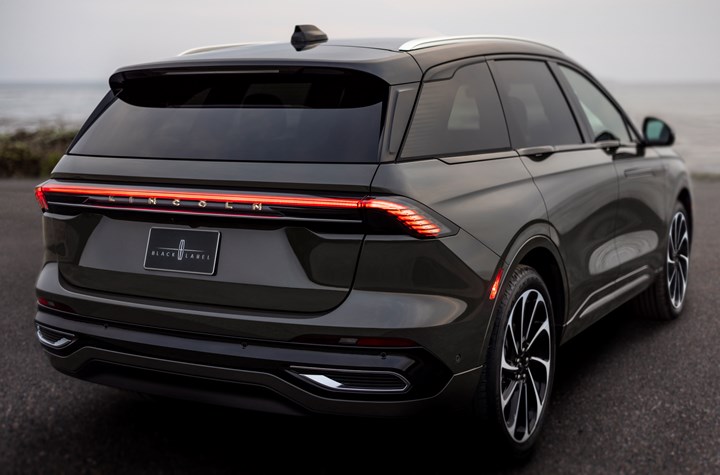
2024 Lincoln Nautilus Black Label. Pay attention to the deliberate lines and the careful details. (Images: Lincoln)
Look very closely at the D-pillar on the 2024 Lincoln Nautilus. See those horizontal lines (hard to discern in that photo, but they’re there)? Now go down to the edge of the tail lamp. See the lines again? The LED tail lamp consists of a single sweep across the hatch, far more gestural than the existing model, which goes across but has two large sections at either end. While this is harder to see in this photo (but not as hard as the D-pillar graphics), below the character line that sweeps from front to back you can discern something that starts on the front quarter panel and moves across the front door. That is the elongated Nautilus badge.
Deliberate horizontal lines and features are fundamental to the exterior design of the new SUV. And on the inside, as well (e.g., on the instrument panel there is a “coast-to-coast” digital display that consists of two 23.6-inch wide screens that are seamlessly integrated).
Earl Lucas, Lincoln chief exterior designer, talks about how the midsize premium SUV exhibits “horizontality.”
Going 2.0
The design language they’ve used for the Nautilus is “Quiet Flight 2.0.”
And the difference between it and the first version?
For one thing, Lucas notes, there are the details. The small but discernable things like the lines in that D-pillar. And the echoes of that throughout.
To the point of “flight,” Lucas points to “the clean, aerodynamic surface that’s reminiscent to modern aircraft and birds in flight, a dynamic [think: aircraft] and graceful [think: birds] exterior.”
Look at the character line. Note how it tapers down in the rear. Lucas says this is representative of a bird’s wing, in flight.
Returning to the tail lamp, again note how the outboard portions resemble wings. What’s more, the housing of the light forms a sharp edge, bringing to mind a contemporary jet (more along the lines of something an Air Force pilot would fly as distinct from one working for Delta).
And as regards the “clean” surface, with the exception of the fender badge, Lucas points to the lack of piercings on the body side: the door handles are integrated into the belt line.
Two Approaches
In the front, there are two distinct faces.
One that is sophisticated:
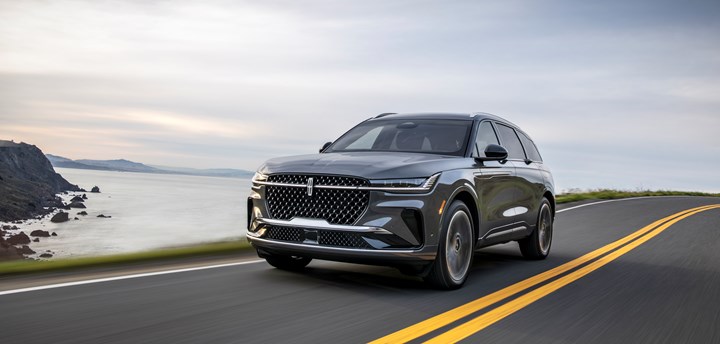
One that is sportier:

Speaking not only of the Nautilus but on models to come, Lucas says: “When you look at the surface language, its about creating a visual attitude that progresses and pushes the brand forward.”
Whereas Lincoln designs (Quiet Flight 1.0) heretofore have been restrained and sophisticated, this new language retains that while bringing more expression to the vehicle design, undoubtedly in order to attract a younger, more forward-thinking clientele to the brand.
///
And Styling the Mercedes-Maybach EQS 680 SUV
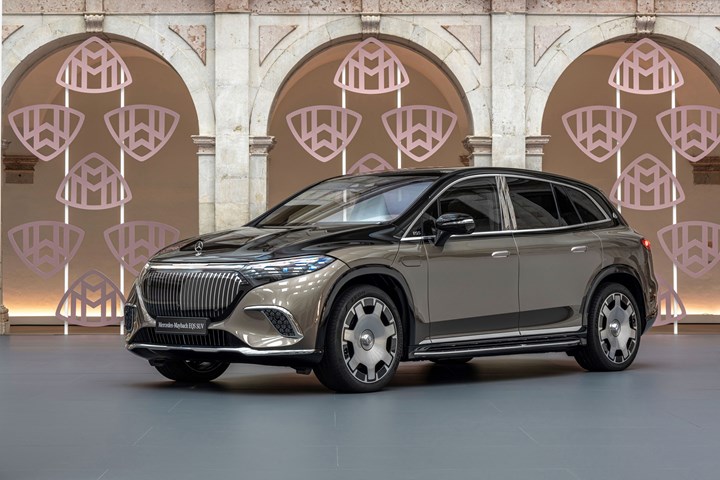
The Mercedes-Maybach EQS 680 electric vehicle. Well, it does have a certain presence. (Image: Mercedes)
“What is good must also be beautiful.” Karl Maybach
The thing about the styling of the Mercedes-Maybach EQS 680—about which Daniel Lescow, head of Mercedes-Maybach, Mercedes-Benz Group AG, said: “For us, it embodies nothing less than the redefinition of automotive excellence in the age of electromobility”—is that there can be no mistake that this is a Mercedes-Maybach. There are plenty of signs that this is luxe (though not necessarily electric).
There’s the Mercedes star on the “hood” (one wonders whether the nomenclature for that closure panel will be changed in light of the electric vehicle as there is no longer an engine under there).
There is the large black panel where there would ordinarily be a grille, but this is smooth and closed. And to provide the visual cue that this is luxury, there are vertical, chrome-plated trim strips that make something of a faux grille look.
Chrome, in fact, is a ubiquitous cue. There are additional slats in the lower grille area and a horizontal band of chrome across the bottom of the fascia, which echoes the chrome at the top, where the word “MAYBACH” is molded into the surface. There are chrome surrounds on the side bumpers. . .surrounding trim sections on either side of the SUV wherein there are a series of Maybach emblems breaking up the space around what appears to be the cover for a parking sensor.
On the side there is a chrome surround for the windows, a chrome B-pillar and a chrome strip above the sill. The running boards have anodized aluminum treads with the pattern meant to echo the look of the grille. While the wheels are brushed metal, the hub caps have both the name of the brand and the Mercedes star in bright metal.
Around back there are chrome pieces on the tailgate, the apron and the spoiler lip.
“At Mercedes-Maybach we strive to add the shine of the extraordinary to the beautiful.”—Gorden Wagener, chief design officer, Mercedes-Benz Group AG.
Well, it is shiny.
///
Merc & Impressive EV Stats
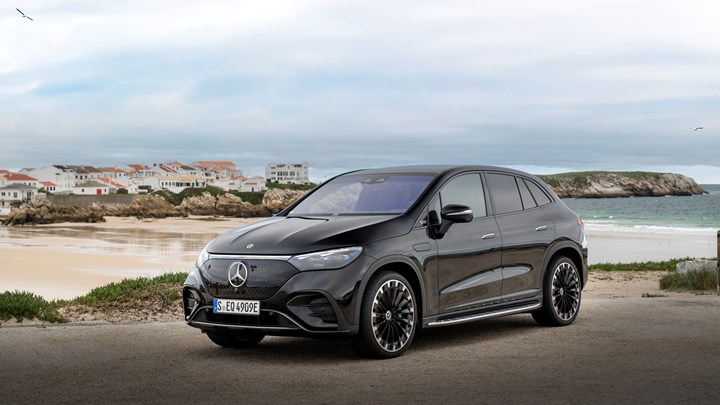
The Mercedes EQE SUV—made in America (Alabama). (Image: Mercedes)
While on the subject of Mercedes. . .
Although Mercedes-Benz sales aren’t particularly huge in the U.S., there’s something worth noting in its Q1 2023 sales figures.
The company delivered 61,531 passenger vehicles. (It also delivered 14,170 vans, but we’ll put those aside.)
Of the 61,531, 7,341 were electric vehicles.
While that is an impressive 251% increase in the number of EVs delivered by Mercedes compared to Q1 2022, what is more impressive is that the 7,341 represent approximately 12% of the company’s sales.
While this might be an apples-to-watermelon comparison, in Q1 GM delivered 603,208 vehicles, of which 20,670 were EVs, or 3.4%.
But GM gets notable number, too: Q1 Chevy Bolt EV deliveries were up 5,402.8% compared to Q1 2022.
Of course, given that the electric Mercedes EQE 350+ SUV starts at $77,900 (and is built in Tuscaloosa, Alabama, incidentally) and the Chevy Bolt EUV has a starting MSRP of $27,800, the fewer number of Mercs sold is probably just fine, margin-wise.
///
E-Bikes Can Be Better
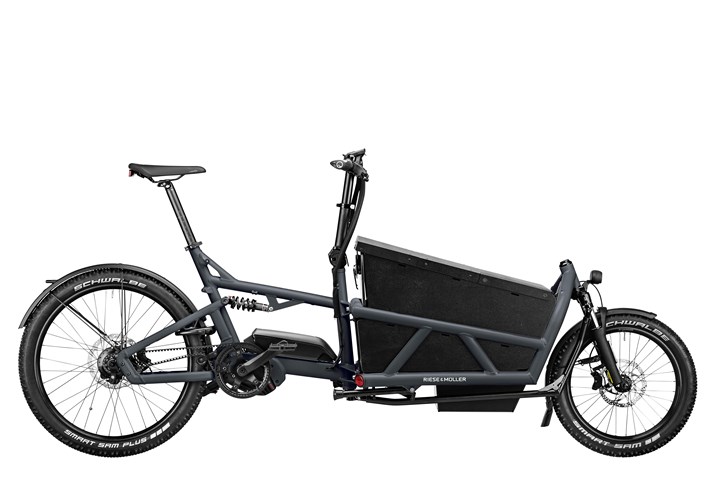
Riese & Müller electric cargo bike. Zip through the streets while carrying stuff. (Image: Riese & Müller)
Transport for London released its “Cargo bike action plan” that is focused on getting more e-cargo bikes on the streets on London.
The TfL study estimates that using cargo bikes in place of vans, there could be a reduction of van miles driven of up to 2% in Greater London by 2025—and as many as 9% in Central London during the same period. Then by 2030 the respective numbers would be up to 4% and 17%.
In terms of emissions, it is calculated that 30,000 tonnes of CO2 per year could be saved by using e-cargo bikes in places of vans for last-mile routes.
And while some people may nod in seeming agreement while performing an eye roll regarding this environmental savings from the e-bikes, TfL also found, “On some routes they are a faster, cheaper alternative to vans as they can use cycle lanes and avoid road congestion.”
The operative word: cheaper.
///
A Lot of Scooters
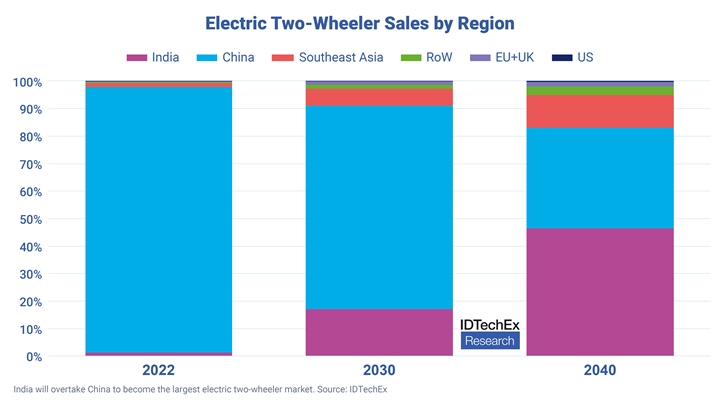
In some parts of the world electric scooters are clearly in demand. In other parts of the world, that demand is barely discernable. (Image: IDTechEx)
Parisians recently voted to ban electric scooters.
Well, not many Parisians: only 7.5% of registered voters went to the polls.
And not all electric scooters, just those that are part of a service (which in the case of Paris are available from three companies, Lime, Tier and Dott): Individuals can still own and operate their own electric two-wheelers.*
While some think the referendum is a serious crack in the growing edifice of micromobility, a look at that chart from IDTechEx shows anything but. . .at least for the Indian, Chinese and Southeast Asian two-wheeler market—although this is more in the context of personal ownership rather than service-based scooters.
The research firm notes that two-wheelers are popular in those parts of the world because:
- Comparatively low incomes mean cars are relatively unaffordable
- Fuel cost rises can make vehicle ownership high (although it also points out that ICE two-wheelers in Indonesia, Thailand, the Philippines, and Vietnam is presently high, but electric versions are growing in popularity there, too)
- Traffic congestion means that two-wheelers are well suited to helping people get places
In China, IDTechEx reports, e-scooter sales hit >30 million in 2016. While there has been a decline, the transition from lead-acid battery power to lithium-ion will case a rise in sales.
In India, it finds strong growth in e-scooter sales, driven by things including supportive government policies and local vehicle manufacturing.
What’s interesting about the IDTechEx bar charts is that it is almost impossible to discern the sales in the EU + UK and the U.S.
No, everything in terms of transportation is not the same everywhere.
\\
*Here’s something to think about. While not exactly a pommes-to-pommes comparison, first know that there are some 15,000 shared e-scooters in Paris. The New York City Department of Transportation conducted a study starting in summer 2021 to determine the usage of micromobility in the outer boroughs, where people have fewer transportation options. The “East Bronx Shared E-Scooter Pilot” final report was released last November. In the study, like Paris, there were three vehicle operators, Bird, Lime and Veo. In phase one there were 3,000 scooters, and the number increased to 6,000 in phase two. Findings included that the e-scooters “had robust ridership”—some 86,000 rider accounts, over 1-million trips in 12 months, or 2,800 trips per day—“and a strong safety record”—no fatalities and only minor injuries were reported. The project seems to have been deemed of success because Ydanis Rodriguez, commissioner of the NYC DoT, writes in the report: “Every New Yorker should have multiple convenient transportation options, and the East Bronx Shared E-Scooter Pilot has made that a reality for thousands.”
So this could mean that if Parisians no longer have access to shared scooters, even if there isn’t a 1:1 rider-to-scooter uptake (i.e., not everyone is going to buy one who had previously used the scooter service), there is potentially an increase in the total number of scooters in Paris. While a private owner is likely not to abandon a scooter willy-nilly, which is a problem in cities, the number of individually owned scooters could be far greater than the number of shared scooters, thereby making the sidewalks and boulevards more congested.
Micromobility is a tricky business.
///Greener PP for Scooters
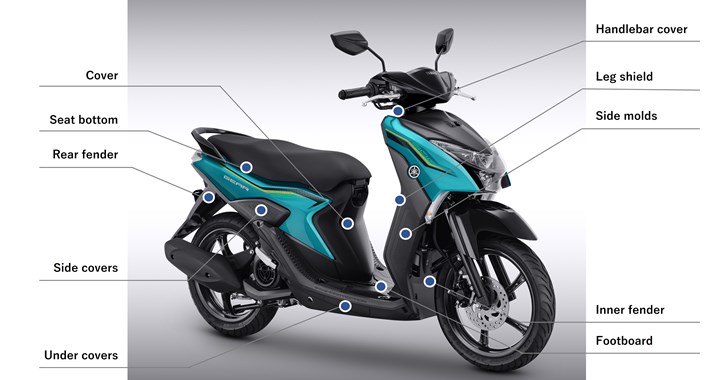
According to Yamaha, about half of all of the plastics used for scooter exteriors are polypropylene. That’s why developing an environmentally friendly recycled PP is important to the company. (Image: Yamaha)
And on the subject of scooters. . .
The ASEAN countries—Brunei Darussalam, Cambodia, Indonesia, Lao PDR, Malaysia, Myanmar, Philippines, Singapore, Thailand, Viet Nam—account for a huge number of scooter sales. Pre-pandemic it was on the order of 25% of the global market, and while it declined during the pandemic, the number have been rising.
So it is interesting that Yamaha Motor Co. has decided that it is going to be deploying a newly developed material for scooters that it will be selling in the ASEAN markets.
It is a polypropylene (PP) that is made only with pre-consumer materials. This recycled PP has a traceable manufacturing history so there will be no hazardous materials (e.g., purging compounds) associated with it.
Yahama has been using recycled materials for its scooters but apparently this new PP provides increased strength and superior aesthetics than conventional recycled plastics.
///
EV Uptake & Income: This Shouldn’t Be a Surprise
The European Automobile Manufacturers’ Association (ACEA) ran a comparison between the average income of European Union (EU) countries and electric vehicle (EV) market share.
And no drumroll please because the findings are, well, somewhat obvious.
Countries with lower annual net incomes have a lower EV share than those with higher incomes.
But the delta between the two is non-trivial.
That is:
- Sweden’s average annual net income is €35,486. EVs have a 56.1% share.
- Slovakia’s average annual net income is €10,985. EVs have a 3.7% share.
The correlation isn’t perfect. For example, the Netherlands has a higher average annual net income--€40,312—than Sweden, yet the EV share is lower, at 34.5%.
And even though Bulgaria’s average annual net income is €7,272, lower than Slovakia’s, its EV share is 5%.
It is worth looking at those number knowing that in 2022 EVs accounted for 21.6% of all new cars registered in the EU.
The ACEA found that more than half of the EU countries have an EV market share of <9%.
The whole notion of “EVs for everyone” has a long way to go in the EU.
(According to the U.S. Bureau of Labor Statistics, the median weekly earnings of the 118.8-million full-time workers in the U.S. in Q4 2022 was $1,085. So if we multiply that by 52, that’s $56,420. According to Kelley Blue Book, in March 2023, the average EV in the U.S. sold for $58,940. “EVs for everyone” has a long way to go in the U.S., too.)
///
Silverado Heavy Duty and Then Some

Sometimes the commute is a bit more challenging. The Chevy Silverado HD ZR2 is made for those moments. (Image: Chevrolet)
While EV and battery announcements continue to garner an outsized amount of attention compared to overall sales of the vehicles—in Q1 2023 Chevy delivered 19,700 Bolt EVs—the continuing story is the success of pickup trucks—in Q1 2023 Chevy delivered 126,992 Silverados.
(And which do you think GM gets better margins on?)
Of that number of Silverado pickups, 36,883 were heavy duties.
For model year 2024 Chevy gave the Silverado HD a stylish refresh both inside and out. Ostensibly a work truck, the modifications provide a look that combines strength and swank.
But there is another phenomenon that is occurring in the market that Chevy has already addressed with its midsize Colorado and the light-duty Silverado: people like to (or like to know that they can) take their trucks off road and go banging around on the rocks.
So there is the Colorado ZR2 and the Silverado ZR2.
Now it is the Silverado HD’s turn for the ZR2 suffix and setup.
The Silverado HD ZR2 is based on the 2500 Crew Cab.
So they’ve taken an already-robust structure and added things to make it more trail capable, like:
- Tailored upper and lower control arms and steering knuckles
- Multimatic spool-valve dampers that offer superior tuning capability
- Rear e-locker
- Off-Road mode that adjusts the throttle response (from either the 6.6-liter gas engine or the 6.6-liter Duramax Turbo Diesel) and the shift points of the Allison 10-speed automatic
- Large steel transfer case skid plate and front aluminum skid plate
For those for whom that’s not enough, there is the HD ZR2 Bison. It was developed with American Expedition Vehicles (AEV). Another mod for it is a greater use of underbody skid plates, which protect the front of the vehicle, steering rack, exhaust, and transfer case.
Let’s face it: rocks can be relentless.
The trucks will be built at GM Flint Assembly this summer.
///
The Viniculture Edition
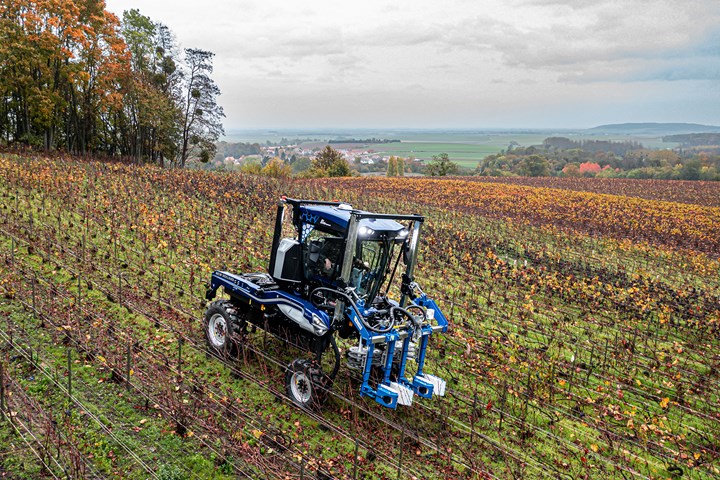
Pininfarina designed this tractor for New Holland to be used in vineyards. (Image: Pininfarina)
Pininfarina designers have been responsible for thing ranging from the Ferrari Testarossa to the Cadillac Alanté, from the Bentley Azure Mark I Convertible to the Alfa Romeo Spider.
The design house also developed the Straddle Tractor Concept.
Yes, as in agricultural equipment.
The concept was developed in collaboration with equipment manufacturer New Holland.
The company has just launched customer versions of the Straddle tractor (availability at the end of 2023), which is designed to operate in and maneuver through the tight rows characteristic of vineyards.
Pininfarina says that the concept design was “inspired by the shape of a glass of Champagne as a homage to premium wine growers of regions such as Champagne, Médoc and Burgundy.”
(Given what it looks like, doesn’t it seem to have been inspired by a sandrail?)
Thierry Le Briquer, New Holland’s Grape, Olive and Coffee Harvester Global Product and Platform Manager*, said, “Multifunctionality, maneuverability, compact design and power: these are the key elements of the new Straddle Tractor range.”
Somehow a Pininfarina-designed tractor would just seem right in places like Champagne.
\\
*What a great title to have on a business card.
///
What In-Car Connected App Do Drivers Want?
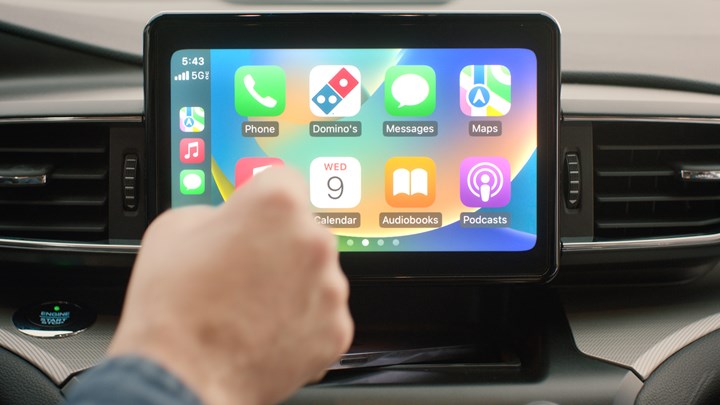
When you need a pizza while driving, Domino’s has a CarPlay app that can help you get it done. (Image: Domino’s)
Domino’s Pizza—which, according to Christopher Thomas-Moore, its senior vp and chief digital officer, “has been known as the industry leader when it comes to pizza and technology”—has made it possible to order a pizza through Apple CarPlay.
Thomas-Moore:
“We know how frustrating it can be to wait in a drive-thru line just to place an order. Domino's app on CarPlay is a great alternative to that, as customers still have the convenience of staying in their car, and can place an order from wherever they are, without waiting in a long drive-thru.”
(Given that for this to work one needs to download the iPhone app it would seem that one could simply use said phone and call, but. . . .)
Survey Says. . .
According to a survey conducted among 4,990 drivers in the U.S., UK, Germany, France, Italy, and China on what connected service the drivers were most interested in, while in-car payments for things ranging from fuel to food was second, the choice of 56% of the global respondents, it was still 12% behind the first choice.
What do drivers want most, according to the “Connected Features Interest Survey Report” conducted by TechInsights?
Information about parking availability.
That’s right: parking. Not pizza.
The survey found parking is the most valuable connected car tech in China, second for European drivers and also second in the U.S., where traffic information is number one.
However, sticking with the U.S., parking space information ranked in first place for drivers between 18 and 24 years old and 35 to 44 years old.
Commenting on the results, Duncan Licence said,
“As our roads get busier and drivers’ lives become more hectic, we are not surprised to see demand for journey-related connected features that make driving safer and more convenient, continuing to rise.”
License is the chief product officer at Parkopedia, a connected car services provider that helps drivers find and pay for. . .parking. (As well as things like fuel and tolls.)
No, Parkopedia did not sponsor the study.
RELATED CONTENT
-
GM Is Down with Diesels
General Motors is one company that is clearly embracing the diesel engine.
-
On The Jeep Grand Cherokee, 2022 Nissan Pathfinder, and More
An inside look at the Detroit Assembly Complex-Mack; a innovative approach to waste-free, two-tone painting; why a forging press is like an F1 car; and other automotive developments.
-
on lots of electric trucks. . .Grand Highlander. . .atomically analyzing additive. . .geometric designs. . .Dodge Hornet. . .
EVs slowdown. . .Ram’s latest in electricity. . .the Grand Highlander is. . .additive at the atomic level. . .advanced—and retro—designs. . .the Dodge Hornet. . .Rimac in reverse. . .


.jpg;width=70;height=70;mode=crop)






